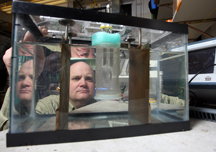Shocking Asian carp out of Midwest rivers not a viable option
December 19, 2012
 |
|
Reuben
Goforth found that the voltage necessary to kill Asian carp embryos and control
the invasive species with electricity would be too high to be safe in rivers.
(Purdue Agricultural Communication photo/Tom Campbell)
|
WEST LAFAYETTE, Ind. – One of the more promising ideas for controlling or eliminating troublesome Asian carp populations in the Midwest's rivers is impractical and unsafe, according to a Purdue University researcher.
Scientists had hoped to modify or expand low-voltage electrical barriers like those used around Chicago waterways to direct fish from particular areas. Reuben Goforth, an assistant professor of aquatic community ecology in the Department of Forestry and Natural Resources, said the level of electricity needed to kill Asian carp eggs in the rivers where the invasive species has spread would be far too high.
"We were really hoping this would be a viable way to control these Asian carp," said Goforth, whose findings were published in the early online version of Transactions of the American Fisheries Society. "We really need to look at other methods."
The several species known as Asian carp - silver carp, black carp and bighead carp - are not native to U.S. waterways but have been found in rivers throughout the Midwest. These fish are competing with native species for food and altering ecosystems. They are also dangerous to boaters and other river users since Asian carp can weight up to 60 pounds and are known to jump out of the water during even minor disturbances.
"They're softer, but imagine going 35 mph in a boat and having something with the mass of a bowling ball hitting you in the face," Goforth said. "There are cases of broken cheeks, broken noses, people being knocked out."
Goforth tested electrical fields on three model species - zebrafish, goldfish and fathead minnows - which are in the same family as Asian carp and have embryos that are similar in size. He found that it took at least 16 volts per centimeter of electricity to kill the embryos.
That's in contrast with 1 volt per centimeter used in electrical barriers around Chicago, which Goforth said have had at least one case in which a boat too close to shore caused a substantial electrical arc.
"Using 16 volts is just too much," he said. "It would be dangerous for people and other aquatic life to put that much electricity in the water. It's a significant hazard.
"Even if we were able to control the population with 8 volts per centimeter, that's a lot of electricity."
Goforth said he would look at other methods to control Asian carp, including using weak electrical fields or hydroacoustics to deter the fish from optimal spawning grounds.
The Great Lakes Restoration Initiative funded the study.
Writer: Brian Wallheimer, 765-496-2050, bwallhei@purdue.edu
Source: Reuben Goforth, 269-967-7620, rgoforth@purdue.edu
ABSTRACT
Evaluating the Effects of Electricity on Fish Embryos as a Potential Strategy for Controlling Invasive Cyprinids
Sam Nutile, Jon J. Amberg, and Reuben R. Goforth
Fish embryo responses to electricity have been evaluated to investigate impacts of electrofishing on survival of fish embryos. However, use of electricity as a lethal means of control for early life history stages of unwanted invasive fish species has not been investigated. We exposed Fathead Minnow Pimephales promelas and Zebrafish Danio rerio embryos at multiple developmental stages to voltage gradients between 2 and 24 V/cm with pulsed direct current (PDC) and virtual direct current (VDC) for 20 and 60 s. Goldfish Carassius auratus embryos were similarly exposed to the same voltage gradients, although these trials were limited to VDC for 60 s. Voltage gradients ≥20 V/cm resulted in significantly lower survival for Fathead Minnow and Zebrafish embryos, and Goldfish embryos exhibited significantly reduced survival at voltage gradients ≥16 V/cm. Zebrafish embryos also exhibited significantly lower survival with longer exposure duration and when exposed to VDC versus PDC, although Fathead Minnow embryo survival did not differ across exposure durations or current types. Based on these results, the use of electrical barriers to control bigheaded carps at early life history stages is likely impractical due to the large voltage gradients and high power densities necessary to transfer lethal power to embryos in open systems with ambient conductivities >300 ̄S/cm. The larger size of bigheaded carp eggs relative to those of our proxy cyprinids may make them more susceptible to lower voltage gradients. However, exploratory tests using a small number of wild-caught bigheaded carp eggs suggested that voltage gradients and associated power densities needed to transfer lethal power to embryos under in situ ambient conductivities were similar to those required to reduce survival in the proxy fish, possibly due to the small size of the bigheaded carp embryos relative to the large void space in water-hardened eggs.
Ag Communications: (765) 494-2722;
Keith Robinson, robins89@purdue.edu
Agriculture News Page

